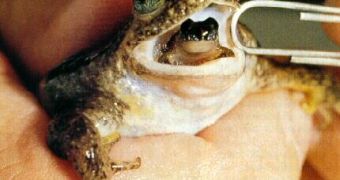A team of researchers working with the University of New South Whales now claim to have succeeded in resurrecting a frog species that went extinct back in 1983.
More precisely, these scientists maintain that, by toying with the gastric-brooding frog's preserved genetic material, they managed to piece together a living embryo of this animal.
Granted, the embryo failed in developing into a tadpole, yet the fact remains that it might not be long until one living and breathing gastric-brooding frog will step out of the laboratory and greet its fans.
According to Tree Hugger, the process of creating this gastric-brooding frog embryo basically revolved around collecting DNA belonging to this species and inserting it into the eggs of a donor frog whose anatomy was fairly similar to that of the extinct species.
At first, the egg seemed reluctant to turn into an embryo. Because of this, the researchers came to believe that their experiments had ended in failure.
“But then, all of a sudden, one of the cells divided, and then it divided again, and again,” explained Mike Archer, one of the researchers working with the University of New South Whales.
“We do expect to get this guy [the gastric-brooding frog] hopping again,” Mike Archer went on to add.
Conservation biologist Michael Mahony, who also worked on this project, wishes to emphasize the fact that, although the techniques they used in order to obtain the gastric-brooding frog embryo are nothing new, their being employed to resurrect an extinct species constitutes a scientific breakthrough.
“This is the first time this technique has been achieved for an extinct species,” Michael Mahony told members of the press.
For those unaware, the gastric-brooding frog was native to remote and relative small regions of Queensland, Australia, and what made it so very special was the fact that, unlike other frogs, it gave birth to its offspring through its mouth.

 14 DAY TRIAL //
14 DAY TRIAL //